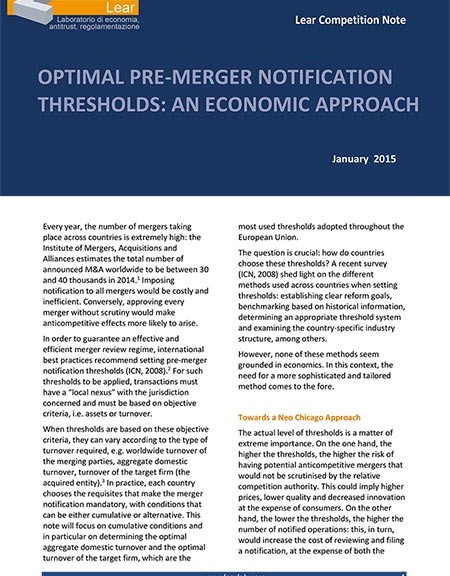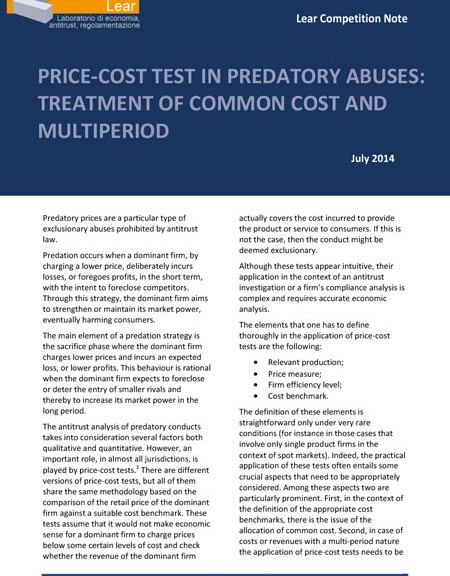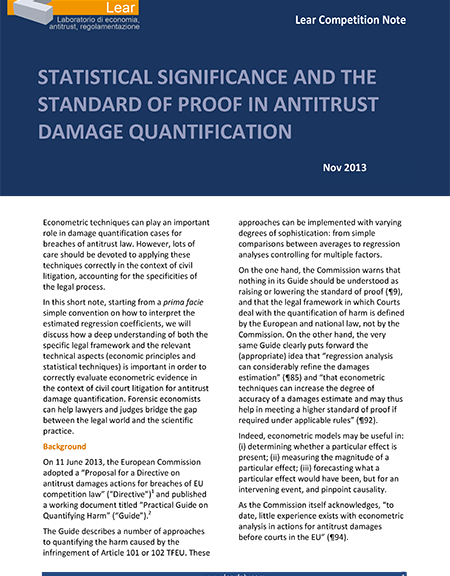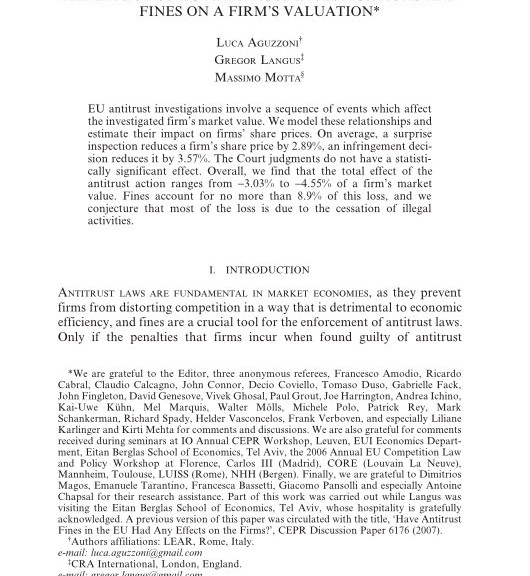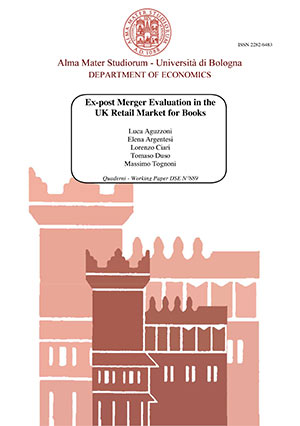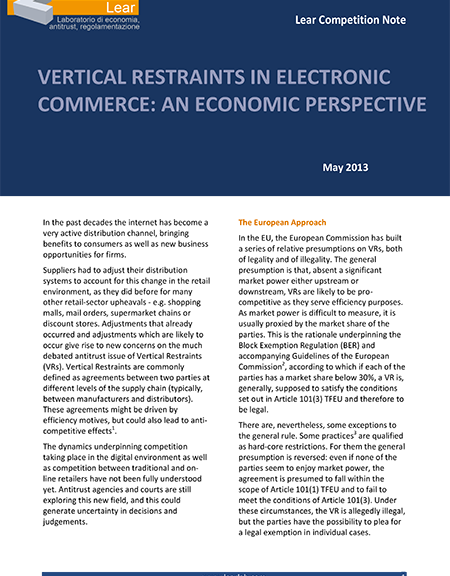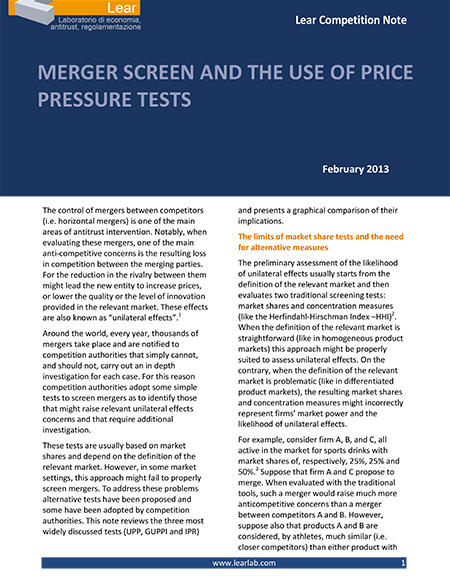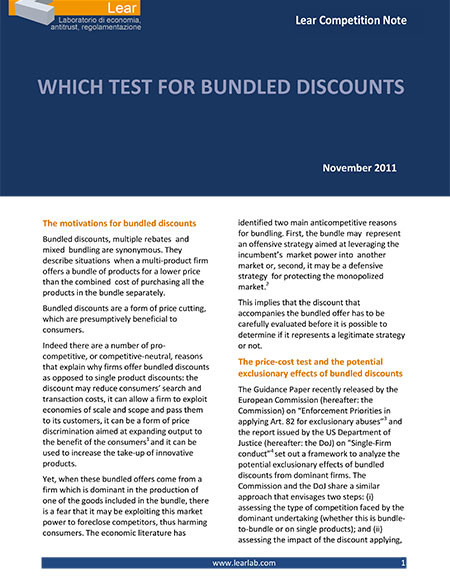The level of pre-merger notification thresholds is a matter of extreme importance to guarantee an effective and efficient merger review regime. On the one hand, the higher the thresholds the higher the risk of having potential anticompetitive mergers that might not be assessed by the relative authority. On the other hand, imposing notification to all mergers would be costly and inefficient for both the competition authority and the merging parties. This note presents an economic approach to set the optimal pre-merger notification threshold and provides some initial thoughts to fill the literature gap on the topic.
Archives
Price-cost test in predatory abuses: treatment of common cost and multiperiod
Predatory prices are a particular type of exclusionary abuse whereby a dominant firm incurs short-term losses by charging a lower price deliberately with the intent to foreclose competitors. The antitrust analysis of predatory conduct entails the application of price-cost tests. These tests are based on the comparison of the retail price of a dominant firm against a suitable cost benchmark. Although these tests appear intuitive, their application in the context of antitrust investigation or of a firm’s compliance analysis is complex and requires accurate economic evaluation. This note describes the crucial aspects that need to be considered in the implementation of the price-cost tests.
Statistical significance and the standard of proof in antitrust damage quantification
Econometric techniques can play an important role in damage quantification cases regarding breaches of antitrust law. In this short note, starting from a prima facie simple convention on how to interpret the estimated regression coefficients, we will discuss how a deep understanding of both the specific legal framework and the relevant technical aspects is important in order to evaluate econometric evidence correctly in the context of civil court litigation for antitrust damage quantification.
The Effect of EU Antitrust Investigations and Fines on a Firm’s Valuation
EU antitrust investigations involve a sequence of events which affect the investigated firm’s market value. We model these relationships and estimate their impact on firms’ share prices. On average, a surprise inspection reduces a firm’s share price by 2.89%, an infringement decision reduces it by 3.57%. The Court judgments do not have a statistically significant effect. Overall, we find that the total effect of the antitrust action ranges from -3.03% to -4.55% of a firm’s market value. Fines account for no more than 8.9% of this loss, and we conjecture that most of the loss is due to the cessation of illegal activities.
Ex-Post Merger Evaluation in the UK Retail Market for Books
This paper empirically evaluates the price effects of the merger of two major book retail chains in the UK: Waterstone’s and Ottakar’s. We employ differences-in-differences techniques and use a rich dataset containing monthly scanner data information on a sample of 200 books sold in 60 stores in 50 different local markets for a period of four years around the merger. Since retail mergers may have either local or national effects (or both) according to the level at which retail chains set prices, we undertake an ex-post assessment of the impact of the merger at both levels. At the local level, we compare the changes in the average price charged before and after the merger in the shops located in overlap areas – i.e. areas where both chains were present before the merger – and in non-overlap areas – i.e. areas where only one chain was present before the merger. At the national level, we employ two distinct control groups to evaluate the merger, namely the competitors and the top-selling titles. We find that the merger did not result in an increase in prices either at the local or at the national level. We also perform heterogeneous treatment effects estimations in order to assess whether the effect of the merger differs along various dimensions of heterogeneity that are present in our data.
Vertical Restraints in Electronic Commerce: an economic perspective
Vertical Restraints (VRs) are commonly defined as agreements between two parties at different levels of the supply chain. These agreements might be driven by efficiency reasons but could also lead to anti-competitive effects. In the past decade, the development of electronic commerce has raised new issues concerning the dynamics underpinning competition in the digital environment as well as competition between traditional and on-line retailers. Through the analysis of the Pierre Fabre Dermo-Cosmétique case, this note seeks to outline a different approach in the assessment of VRs in electronic markets and analyses some critical issues that are often neglected.
Merger screen and the use of price pressure test
Mergers between competitors might generate relevant anti-competitive effects. Therefore, competition authorities need effective tests to make a preliminary assessment of the likelihood of unilateral effects of horizontal mergers. These tests are usually based on market shares and rely on the definition of the relevant market. However, in some market settings, this approach might fail to screen mergers adequately. To overcome the limitation of traditional tools some alternative tests have been proposed. This note reviews the Upward Pricing Pressure (UPP), the Gross Upward Pricing Pressure Index (GUPPI) and the Illustrative Price Rise (IPR) and presents a graphical comparison of their implications.
Price Relationship Agreements: economic analysis and implications for competition
Price Relationship Agreements (PRAs) are agreements linking one supplier’s price to those charged to other customers or by competitors. Firms adopt PRAs for many different reasons and the competitive effects of these agreements may vary substantially. This note summarizes the main findings of a comprehensive literature review of PRAs, bringing together different economic theories of harm and efficiency motivations, and provides some policy implications.
Can ‘Fair’ Prices Be Unfair? A Review of Price Relationship Agreements
The report, prepared for the OFT by LEAR, examines the various forms these agreements can take, their potential benefits and anti-competitive effects, drawing on economic literature and relevant case law. The OFT will present the findings today at a joint workshop held by the US Federal Trade Commission and Department of Justice on the implications for antitrust policy and enforcement of ‘most-favoured nation’ (MFN) clauses, which are a type of price relationship agreement.
The report suggests that while some types of price relationship agreements could be attractive to buyers, they could also have a softening effect on competition. For example, shoppers offered a ‘lowest price’ guarantee may not bother to shop around as much as they would otherwise, thus reducing the downward pressure on prices. Furthermore, if a rival of a ‘lowest price’ retailer knows that any price reduction will quickly be matched or beaten, the incentive to lower prices may be reduced.
Which test for bundled discounts
Bundled discounts are a form of price cutting which are presumptively beneficial to consumers. However, bundle offers from a dominant firm might exploit market power to foreclose competitors, thus harming consumers. The European Commission and the DoJ set out a framework to analyze the potential exclusionary effects of bundled discounts by dominant firms. Focusing on the implementation of the price-cost test, this note discusses two issues that neither the DoJ nor the Commission have addressed so far. Namely, the evaluation of the nature of competition in the relevant markets and the rule to allocate the discount across the products when bundle-to-bundle competition is not possible.

